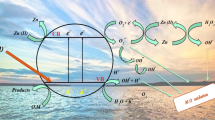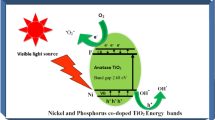Abstract
In order to optimize the water purification and treatment of polluted water, a new degradation technique of the organic matter called “heterogeneous photocatalysis” has been highlighted. Titanium dioxide TiO2 semiconductor doped with Ni has been chosen as photocatalyst, which has been prepared by coprecipitation. The characterization of synthesized catalysts has been carried out using transmission electron microscopy, X-ray diffraction and diffuse reflectance spectroscopy and scanning electron microscopy as well as EDS. The obtained adsorption results showed that the dye adsorbs better on doped TiO2 nanoparticles rather than pure TiO2. The kinetics of photodegradation was studied as a function of several parameters, such as the concentration and the nature of the catalysts, the doping element and the initial concentration of methyl orange dye. Comparisons of degradation kinetics of methyl orange using TiO2 semiconductors have shown that pure TiO2 Sachtopore and doped TiO2 Sachtopore at 0.1% are less active compared to TiO2 P25 and doped TiO2 Sachtopore at 0.2% since they provide comparable performance.















Similar content being viewed by others
References
Baiocchi C, Brussino MC, Pramauroa E, Prevot AB, Palmisano L, Marci G (2002) Characterization of methyl orange and its photocatalytic degradation products by HPLC/UV–VIS diode array and atmospheric pressure ionization quadrupole ion trap mass spectrometry. Int J Mass Spectrom 214:247–256
Behnajady MA, Modirshahla N, Daneshvar N, Rabbani M (2007) Photocatalytic degradation of C.I. acid red 27 by immobilized ZnO on glass plates in continuous-mode. J Hazard Mater 140:257–263
Eskandarloo H, Badiei A, Haug C (2014) Enhanced photocatalytic degradation of an azo textile dye by using TiO2/NiO coupled nanoparticles: optimization of synthesis and operational key factors. Mater Sci Semicond Process 27:240–253
Mohammadzadeha M, Behnajady MA, Eskandarloo H (2016) Hybridized advanced oxidation processes involving UV/H 2 O 2/S 2 O 8 2-for photooxidative removal of p-nitrophenol in an annular continuous-flow photoreactor. Kinet Catal 57:768–775
Tian Y, Yuan X, Xu S, Li R, Zhou X, Zhang Z (2015) Biological efficacy and toxic effect of emergency water disinfection process based on advanced oxidation technology. Ecotoxilogy 24:2141–2150
Wang JL, Xu LJ (2012) Advanced oxidation processes for wastewater treatment: formation of hydroxyl radical and application. Crit Rev Environ Sci Technol 42:251–325
Bautista P, Mohedano AF, Casas JA, Zazo JA, Rodriguez JJ (2008) An overview of the application of fenton oxidation to industrial wastewaters treatment. J Chem Technol Biotechnol 83:1323–1338
Li Y, Guo L, Huang D, Jawad A, Chen Z, Yang J, Liu W, Shen Y, Wang M, Yin G (2017) Support-dependent active species formation for CuO catalysts: leading to efficient pollutant degradation in alkaline conditions. J Hazard Mater 328:56–62
Roozban N, Abbasi S, Ghazizadeh M (2016) Statistical analysis of the photocatalytic activity of decorated multi-walled carbon nanotubes with ZnO nanoparticles. J Mater Sci Mater Electron 28(8):6047–6055. https://doi.org/10.1007/s10854-016-6280-9
Ounnar A, Favier L, Bouzaza A, Bentahar F, Trari M (2016) Kinetic study of spiramycin removal from aqueous solution using heterogeneous photocatalysis. Kinectics and catalysis 57:200–206
Lizama-Bahena C, Álvarez-Gallegos A, Hernandez JA, Silva-Martinez S (2015) Elimination of bio-refractory chlorinated herbicides like atrazine, alachlor, and chlorbromuron from aqueous effluents by Fenton, electro-Fenton, and peroxi-coagulation methods. Desalin Water Treat 55:3683–3693
Arellano CAP, González AJ, Martínez SS, Salgado-Tránsito I, Franco CP (2013) Enhanced mineralization of atrazine by means of photodegradation processes using solar energy at pilot plant scale. J Photochem Photobiol Chem 272:21–27
Jaimes R, Pineda CA, Álvarez AA, Jiménez AE, Silva S (2015) H2O2-assisted TiO2 generation during the photoelectrocatalytic process to decompose the acid green textile dye by Fenton reaction. J Photochem Photobiol Chem 305:51–59
Domínguez-Espíndola RB, Varia JC, Álvarez-Gallegos A, Ortiz-Hernández ML, Peña-Camacho JL, Silva-Martínez S (2016) Photoelectrocatalytic inactivation of fecal coliform bacteria in urban wastewater using nanoparticulated films of TiO2 and TiO2/Ag. Environ Technol 38:1–9
Gutierrez-Mata AG, Velazquez-Martínez S, Álvarez-Gallegos A, Ahmadi M, Hernández-Pérez JA, Ghanbari F, Silva-Martínez S (2017) Recent overview of solar photocatalysis and solar photo-Fenton processes for wastewater treatment. Int J Photoenergy. https://doi.org/10.1155/2017/8528063
Sökmen M, Özkan A (2002) Decolourising textile wastewater with modified titania: the effects of inorganic anions on the photocatalysis. J Photochem Photobiol Chem 147:77–81
Qourzal S, Barka N, Tamimi M, Assabbane A, Ait-Ichou Y (2008) Photodegradation of 2-naphthol in water by artificial light illumination using TiO2 photocatalyst: identification of intermediates and the reaction pathway. Appl Catal Gen 334:386–393
Wu HC, Lin YS, Lin SW (2013) Mechanisms of visible light photocatalysis in N-doped anatase TiO2 with oxygen vacancies from GGA+ U calculations. Int J Photoenergy 2013:7
Abbasi S, Hasanpour M (2016) The effect of pH on the photocatalytic degradation of methyl orange using decorated ZnO nanoparticles with SnO2 nanoparticles. J Mater Sci-Mater Electron 28:1307–1314. https://doi.org/10.1007/s10854-016-5660-5
Abbasi S, Saddat M, Kakhki E, Tahari M (2017) A multi-material coating containing chemically-modified apatites for combined enhanced bioactivity and reduced infection via a drop-on-demand micro-dispensing technique. J Mater Sci: Mater Electron 28:3. https://doi.org/10.1007/s10854-017-7414-4
Abbasi S (2020) Response surface methodology for photo degradation of methyl orange using magnetic nanocomposites containing zinc oxide. J Cluster Sci. https://doi.org/10.1007/s10876-020-01847-y
Tian L, Liu H, Gao Y (2012) Degradation and adsorption of rhodamine B and phenol on TiO2/MCM-41. Kinet Catal 53:554–559
Sahu N, Parida KM (2012) Photocatalytic activity of Au/TiO2 nanocomposite for azo-dyes degradation. Kinet Catal 53:197–205
Sacco O, Stoller M, Vaiano V, Ciambelli P, Chianese A, Sannino D (2012) Photocatalytic degradation of organic dyes under visible light on N-doped TiO 2 photocatalysts. Int J Photoenergy 2012:8
Yang H, Li G, An T, Gao Y, Fu J (2010) Photocatalytic degradation kinetics and mechanism of environmental pharmaceuticals in aqueous suspension of TiO2: A case of sulfa drugs. Catal Today 153:200
Tseng YH, Huang B-K (2011) Photocatalytic degradation of using Ni-containing TiO2. Hindawi Publ Corp Int J Photoenergy 2012:1–7. https://doi.org/10.1155/2012/832180
Nguyen CH, Fu CC, Juang RS (2018) Degradation of methylene blue and methyl orange by palladium-doped TiO2 photocatalysis for water reuse: efficiency and degradation pathways. J Clean Prod 202:413–427
Panda N, Sahoo H, Mohapatra S (2011) Decolourization of methyl orange using fenton-like mesoporous Fe2O3–SiO2 composite. J Hazard Mater 185:359–365
Ellouzi I, El Hajjaji S, Harir M, Koplin PS, Laânab L (2019) Synergistic effects of C, N, S, Fe-multidoped TiO2 for photocatalytic degradation of methyl orange dye under UV and visible light irradiations. Int J Environ Res 1(8):1–8
Ellouzi I, El Hajjaji S, Harir M, Koplin PS, Robert D, Laânab L (2020) Synergistic effects of C, N, S, Fe-multidoped TiO 2 for photocatalytic degradation of methyl orange dye under UV and visible light irradiations. SN Appl Sci 1:1–8
Huang J, Li D, Li R, Chen P, Zhang Q, Liu H, Lv W, Liu G, Feng Y (2019) One-step synthesis of phosphorus/oxygen co-doped g-C3N4/anatase TiO2 Z-scheme photocatalyst for significantly enhanced visible-light photocatalysis degradation of enrofloxacin. J Hazard Mater. https://doi.org/10.1016/j.jhazmat.2019.121634
Troppová I, Šihor M, Reli M, Ritz M, Praus P, Kočí K (2018) Unconventionally prepared TiO2/g-C3N4 photocatalysts for photocatalytic decomposition of nitrous oxide. J Appl Surf Sci 430:335–347
Tang H, Prasad K, Sanjinès R, Schmid PE, Lévy F (1994) Electrical and optical properties of TiO2 anatase thin films. J Appl Phys 75:2042
Chiarello GL, Paola D, and Selli E (2011) From: 6th European meeting on solar chemistry and photocatalysis: environmental applications effect of titanium dioxide crystalline structure on the photocatalytic production of hydrogen. Society Issue Iii
Atchudan RR, Edison TNJI, Mani S, Perumal S, Vinodh R, Thirunavukkarasu S, Lee YR (2020) Facile synthesis of a novel nitrogen-doped carbon dot adorned Zinc oxide composite for photodegradation of methylene blue. Dalton Trans 49:17725–17736. https://doi.org/10.1039/D0DT02756A
Wang D, Zhang J, Luo Q, Li X, Duan Y, An J (2009) Characterization and photocatalytic activity of poly(3-hexylthiophene)-modified TiO2 for degradation of methyl orange under visible light. J Hazard Mater 169:546–550
Salah NH (2012) Study of the photocatalytic degradation of organic pollutants in the presence of titanium dioxide. In aqueous suspension and in fixed bed, thesis, University of Grenoble, France
Barka N (2008) The elimination of synthetic dyes by adsorption on a natural phosphate and by photocatalytic degradation on supported TiO2, thesis, faculty of sciences, Agadir, Morocco
Belmouden M, Assabbane A, Ait-Ichou Y (2000) Adsorption characteristics of a phenoxy acetic acid herbicide on activated carbon. J Environ Monit 2:257–260
Kaura T, Toorb AP, Wanchoob RK (2015) UV-assisted degradation of propiconozole in a TiO2 aqueous suspension: identification of transformation produits and the reaction pathway using GC/MS. Int J Environ Analytical Chem 95(6):494–507
Vaez Z, Javanbakht V (2019) Synthesis, characterization and photocatalytic activity of ZSM-5/ZnO nanocomposite modified by Ag nanoparticles for methyl orange degradation. J Photochem Photobiol Chem. https://doi.org/10.1016/j.jphotochem.2019.112064
Yetim T, Tekin T (2016) Synergistic effect of sonolysis and photocatalysis in the degradation kinetics of effluent solution. Kinet Catal 57:578–585
Yan Y, Wang X, Khan MA, Xia M, Lei W, Wang F (2019) Synthesis and characterisation of (Fe, Co, Ni)-polyoxometalates to degrade O, O-diethyl-S-(p-tolyl) phosphorothioate under visible light irradiation. Int J Environ Analytical Chem. https://doi.org/10.1080/03067319.2019.1653459
Talebian N, Nilforoushan MR, Mogaddas FJ (2013) Comparative study on the sonophotocatalytic degradation of hazardous waste. Ceram Int 39:4913–4921
El Yadini A, Marouane B, Ahmido A, Dunlop P, Anthony Byrne J, EL Azzouzi M, EL Hajjaji S (2013) Photolysis and photodegradation of Fenamiphos insecticide by using slurry and supported TiO2. J Mater Environ Sci 4(6):973–980
El Yadini A, Saufi H, Dunlop PSM, Anthony Byrne J, El Azzouzi M, El Hajjaji S (2014) Supported TiO2 on borosilicate glass plates for efficient photocatalytic degradation of fenamiphos. J Catal 2014:8
Znad H, Abba K, Hena S, Awual MR (2018) Synthesis a novel multilamellar mesoporous TiO2/ZSM-5 for photo-catalytic degradation of methyl orange dye in aqueous media. J Envir Chem Eng. 6:218–227
Ellouzi I, Elayazi L, Harir M, Schmitt-Kopplin P, Laanab L, Mountacer H, El Hajjaji S (2015) Synthesis and characterization of C, N, S and Fe modified TiO2 nanophotocatalysist: Efficiency on the degradation of methyl orange and levafix blue. J Phys Chem News 75:60–67
Bansal P, Verma A (2018) N, Ag co-doped TiO2 mediated modified in-situ dual process (modified photocatalysis and photo-Fenton) in fixed-mode for the degradation of Cephalexin under solar irradiations. Chemosphere 212:611–619
Abbasi S, Ekrami-Kakhki M-S (2019) The influence of ZnO nanoparticles amount on the optimisation of photo degradation of methyl orange using decorated MWCNTs. Prog Ind Ecology Int J 13(1):3. https://doi.org/10.1504/PIE.2019.098760
Abbasi S, Hasanpour M (2017) The effect of pH on the photocatalytic degradation of methyl orange using decorated ZnO nanoparticles with SnO 2 nanoparticles. J Mater Sci Mater Electron. https://doi.org/10.1007/s10854-017-6992-5
Abbasi S, Hasanpour M, Ahmadpoor F, Sillanpää M, Dastan D, Achour A (2019) Application of the statistical analysis methodology for photodegradation of methyl orange using a new nanocomposite containing modified TiO2 semiconductor with SnO2. Int J Environ Anal Chem. https://doi.org/10.1080/03067319.2019.1662414
Abbasi S (2018) Investigation of the enhancement and optimization of the photocatalytic activity of modified TiO2 nanoparticles with SnO2 nanoparticles using statistical method. Mater Res Express. https://doi.org/10.1088/2053-1591/aac7f4
Author information
Authors and Affiliations
Corresponding author
Additional information
Publisher's Note
Springer Nature remains neutral with regard to jurisdictional claims in published maps and institutional affiliations.
Rights and permissions
About this article
Cite this article
Regraguy, B., Rahmani, M., Mabrouki, J. et al. Photocatalytic degradation of methyl orange in the presence of nanoparticles NiSO4/TiO2. Nanotechnol. Environ. Eng. 7, 157–171 (2022). https://doi.org/10.1007/s41204-021-00206-0
Received:
Accepted:
Published:
Issue Date:
DOI: https://doi.org/10.1007/s41204-021-00206-0




